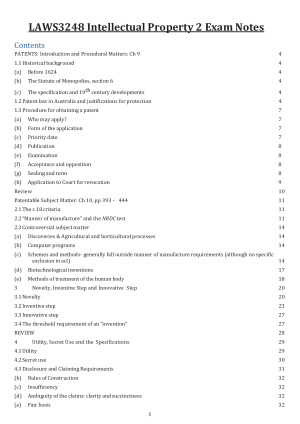LAWS3248 Intellectual Property 2 Exam Notes
Subject notes for UNSW LAWS3248
Description
LAWS3248 Intellectual Property 2 Exam Notes Contents PATENTS: Introduction and Procedural Matters: Ch 9 4 Historical background 4 (a) Before 1624 4 (b) The Statute of Monopolies, section 6 4 (c) The specification and 19th century developments 4 Patent law in Australia and justifications for protection 4 Procedure for obtaining a patent 7 (a) Who may apply? 7 (b) Form of the application 7 (c) Priority date 7 (d) Publication 8 (e) Examination 8 (f) Acceptance and opposition 8 (g) Sealing and term 8 (h) Application to Court for revocation 9 Review 10 Patentable Subject Matter: Ch 10, pp 393 - 444 11 The s 18 criteria 11 “Manner of manufacture” and the NRDC test 11 Controversial subject matter 14 (a) Discoveries & Agricultural and horticultural processes 14 (b) Computer programs 14 (c) Schemes and methods- generally fall outside manner of manufacture requirements (although no specific exclusion in act) 14 (d) Biotechnological inventions 17 (e) Methods of treatment of the human body 18 3 Novelty, Inventive Step and Innovative Step 20 Novelty 20 Inventive step 23 Innovative step 27 The threshold requirement of an “invention” 27 REVIEW 28 4 Utility, Secret Use and the Specifications 29 Utility 29 Secret use 30 Disclosure and Claiming Requirements 31 (b) Rules of Construction 32 (c) Insufficiency 32 (d) Ambiguity of the claims: clarity and succinctness 32 (e) Fair basis 32 (f) An error in the specification 33 (g) Disclosure and claiming requirements in other jurisdictions 33 CHAPTER 15: TRADE MARKS, PASSING OFF AND PROTECTING TRADE REPUTATION: HISTORY, JUSTIFICATIONS AND CONTEXT 34 CHAPTER 16: PASSING OFF AND CONSUMER PROTECTION LEGISLATION 37 TESTS FOR PASSING OFF AND CONTRAVENTION OF ACL 37 To what does the reputation attach? 38 REPUTATION IN PACKAGING, PRODUCT SHAPE AND OTHER INDICIA 40 LOCATION OF REPUTATION 41 MISPRESENTATION, OR MISLEADING OR DECEPTIVE CONDUCT 43 Preliminary issues 43 Types of misrepresentation 45 Origin-main type of misrepresentation 45 Quality 46 Damage 49 Types of damage 49 Damages and remedies 49 CHAPTER 17: REGISTERED TRADE MARKS: PROCEDURAL AND SUBSTANTIVE REQUIREMENTS FOR REGISTRATION 50 Application 50 Examinations 51 Acceptance and opposition 51 Registration and renewal 52 Loss of rights 52 The definition of a trade mark 52 EXAMINATION, OPPOSITION AND CANCELLATION GROUNDS 53 Absolute Grounds of Refusal: Distinctiveness (s 41) 54 Other Absolute and Relative Grounds of Refusal 59 Other absolute grounds of rejection/opposition 59 Relative grounds of refusal [7 relative grounds of refusal: ss 44, 60, 42(b), 43, 58, 62A and 61] 62 (a) Conflicts with earlier registered marks or applications for registration 62 ALL IN OPPOSITION; A LOT OF OVERLAP: 66 (c) The expanded reach of s 42(b) and s 43 as opposition grounds 67 (d) Applicant not the owner 67 (e) Application made in bad faith 68 CHAPTER 18: Infringement, Defences, Loss of Rights and Exploitation 69 Infringement 69 (b) Use ‘as a trade mark’ 71 (d) The s 120(2) proviso: “using the sign as the person did is not likely to deceive or cause confusion” 75 (e) Section 120(3) 75 Defences to infringement 76 (b) Descriptive or nominative use 77 (c) Comparative advertising 77 (d) Defendant would obtain registration in its own name 77 (e) Parallel importation / sale of legitimate second hand goods 77 (f) Prior use 78 Loss of Rights 78 LOSS OF RIGHTS 78 REMOVAL ON THE BASIS OF NON-USE 79 Exploitation 82
UNSW
Term 3, 2020
83 pages
31,585 words
$59.00
4
Campus
UNSW, Kensington
Member since
September 2020
